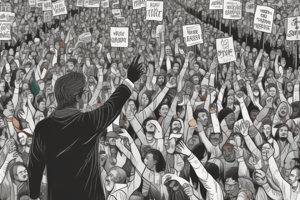Podcast
Questions and Answers
What is a defining characteristic of a social movement?
What is a defining characteristic of a social movement?
- It is primarily motivated by external pressures.
- It always operates within a rigid organizational framework.
- It springs largely from the attitudes and aspirations of members. (correct)
- It focuses solely on economic advantages.
Which type of social movement aims to effect large-scale significant change within an existing society?
Which type of social movement aims to effect large-scale significant change within an existing society?
- Reformative social movement (correct)
- Reactionary movement
- Revolutionary social movement
- Alternative social movement
What stage of social movements involves the initial awareness of an issue?
What stage of social movements involves the initial awareness of an issue?
- Bureaucratization
- Coalescence
- Decline
- Emergence (correct)
What do mobilizing structures facilitate in social movements?
What do mobilizing structures facilitate in social movements?
Which factor does NOT belong to the opportunity structures for social movements?
Which factor does NOT belong to the opportunity structures for social movements?
Which form of motivation includes a desire to belong to a group in social movements?
Which form of motivation includes a desire to belong to a group in social movements?
What is the primary goal of framing processes within social movements?
What is the primary goal of framing processes within social movements?
Which of the following movements fights against existing societal changes rather than advocating for new ones?
Which of the following movements fights against existing societal changes rather than advocating for new ones?
What is a key feature of opportunity structures in social movements?
What is a key feature of opportunity structures in social movements?
In what stage of social movements does an organization begin to formalize its structure?
In what stage of social movements does an organization begin to formalize its structure?
Which type of social movement seeks to bring about specific changes while keeping the existing social structure intact?
Which type of social movement seeks to bring about specific changes while keeping the existing social structure intact?
What motivates individuals to participate in social movements aside from personal advantage?
What motivates individuals to participate in social movements aside from personal advantage?
Which stage of a social movement is characterized by the decline of activity and influence?
Which stage of a social movement is characterized by the decline of activity and influence?
What are mobilizing structures primarily concerned with in social movements?
What are mobilizing structures primarily concerned with in social movements?
Which of the following best describes framing processes in social movements?
Which of the following best describes framing processes in social movements?
Which emotion may influence an individual's decision to join a social movement?
Which emotion may influence an individual's decision to join a social movement?
Flashcards
Social Movement
Social Movement
A form of collective action motivated by members' attitudes and aspirations, typically operating within a loose organizational structure.
Types of Social Movements
Types of Social Movements
Different types exist: alternative, redemptive, reformative, revolutionary, and reactionary.
Social Movement Motivation
Social Movement Motivation
Motivations include personal gain, strong beliefs, self-identity, and group belonging.
Stages of Social Movements
Stages of Social Movements
Signup and view all the flashcards
Mobilizing Structures
Mobilizing Structures
Signup and view all the flashcards
Opportunity Structures
Opportunity Structures
Signup and view all the flashcards
Framing Processes
Framing Processes
Signup and view all the flashcards
Claims Making
Claims Making
Signup and view all the flashcards
What is a social movement?
What is a social movement?
Signup and view all the flashcards
Alternative movement
Alternative movement
Signup and view all the flashcards
Redemptive movement
Redemptive movement
Signup and view all the flashcards
Reformative movement
Reformative movement
Signup and view all the flashcards
Revolutionary movement
Revolutionary movement
Signup and view all the flashcards
Reactionary movement
Reactionary movement
Signup and view all the flashcards
What are opportunity structures?
What are opportunity structures?
Signup and view all the flashcards
What are framing processes?
What are framing processes?
Signup and view all the flashcards
Study Notes
Social Movements
- A social movement is a form of collective behavior where motivations stem largely from members' attitudes and aspirations, operating within a loose organizational structure.
Types of Social Movements
- Alternative: Limited goals, focused on specific changes in behavior
- Redemptive: Aims for a fundamental change in individuals
- Reformative: Seeks to achieve limited, targeted societal reforms
- Revolutionary: Seeks comprehensive societal transformation
- Reactionary: Aims to restore an earlier state or way of life
Motivation
- Personal advantage
- Principled commitment
- Sense of self-identity
- Desire to be a part of a group
- Claims-making
Stages of Social Movements
- Emergence: Initial stage, ideas emerge and grow.
- Coalescence: Gathering momentum, individuals join together.
- Bureaucratization: Formalization of structure and procedures becomes crucial.
- Decline: Movement's goal is achieved or loses interest.
Formation of Movements
- Mobilizing structures: Mechanisms for organization and collective action (social structures, tactics).
- Opportunity structures: Environmental conditions that facilitate movement activity (political accessibility, presence of allies).
- Framing processes: Strategic crafting and dissemination of messages and narratives to justify claims and actions.
Mobilizing Structures
- Participation level
- Contentious activity
- Organizational issues
Opportunity Structures
- Relative accessibility of the political system
- Stability or fragmentation of elite alignments
- Presence of elite allies
- State's capacity and propensity for repression
Framing Processes
- Ability to bypass mass media
- Flexible dissemination strategies
- New channels
New Social Movements
- Capacity to attract young, educated, and relatively affluent members.
- Postmaterial orientation
- Commitment to new forms of political activism.
Collective vs Connective Action
- Digitalization
- Individualized frames
Connective Action (Networks)
- Loose organizational structure.
- Organizations use social tech to support members.
- Primarily based on shared values and experiences.
Collective Action (Brokered Networks)
- Strong organizational coordination of action
- Social technologies used by organizations to manage social movement participation, coordinate goals
- Focus on collective action frames.
Studying That Suits You
Use AI to generate personalized quizzes and flashcards to suit your learning preferences.




